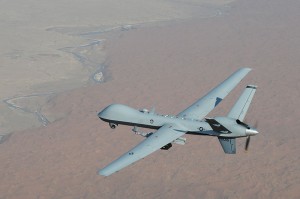 Unequivocally, 2012 has been the year of the drone. While few dispute that the US Government needs to engage both the American people and the international community in an informed dialogue on its use of UAVs (Unmanned Aerial Vehicles) in counterterrorism (CT) operations, the shape this dialogue should take remains unclear.
Unequivocally, 2012 has been the year of the drone. While few dispute that the US Government needs to engage both the American people and the international community in an informed dialogue on its use of UAVs (Unmanned Aerial Vehicles) in counterterrorism (CT) operations, the shape this dialogue should take remains unclear.
To preserve its integrity in the court of global public opinion, the US needs a forum in which an informed and apolitical conversation about its drone policy can occur with the aim of achieving several specific objectives. The US is quickly establishing an international precedent for the use of this technology in non-combat settings, the implications of which only increase the urgency with which this dialogue must occur.
The current discourse has led to a polarization of opinion, resulting in categorical demands to end or expand the use of drones. These polemics, driven by either the absence or politicization of factual information, are of limited utility because they fail to address the key strategic, legal, moral, and ethical considerations that have burdened US drone programs since their inception.
Since the signing of the 2001 AUMF (Authorization for Use of Military Force) permitting the use of military force against terrorism, drones have been presented as a fiscally-prudent option for the execution of precision strikes with limited collateral and low risk to US troops. The US currently operates two drone programs, one overt in the declared combat spaces of Afghanistan, Iraq, and Libya; and a second, covert program in the non-combat spaces of Pakistan, Somalia, and Yemen.
Little public information is available about either program, with data on operational methods, strikes, kill rates, and costs varying widely and being largely speculative in some instances. It is known that among a broadening drone arsenal, US forces preeminently employ MQ-9 Reapers, MQ-1B Predators, and RQ-4 Global Hawks in these operations, with recent estimates indicating approximately 31% of US military aircraft are now UAVs.
As both programs have rapidly and dramatically expanded under the Obama Administration, so too have concerns about the use of drones for targeted killings in non-combat areas. The US has not yet provided legal justification for its use of drones in relation to any international legal framework. Additionally, questions proliferate as to whether it is morally permissible to target and eliminate an individual, or ethical to do so without the due process of law.
Superseding these considerations is whether drone strikes are effective in achieving strategic objectives. There is a growing body of evidence that despite decentralizing terrorist organizations and decreasing their numbers, US drone strikes are nurturing a backlash that drives targeted populations toward militancy. The potential manifestation of this backlash has serious short- and long-term implications for which US policymaking has not yet accounted. However, it is unclear that there is a better strategy for combating terrorism in nations where the domestic governments have failed to make headway.
A dialogue on US drone policy is needed, but the question remains: what should such a dialogue aim to achieve? While seeking a categorical imperative governing the use of drones is too ambitious at the outset, there are several concrete goals the discourse should achieve.
1. Disclose previous and ongoing US drone operations. It is understood that governments are bound by requirements of National Security to keep certain operations secret. While honoring this requirement, the US must be transparent about all non-classified information including where drones operate, the means and methods of their usage, as well as statistical strike data.
2. Articulate the current US policy on the use of drones and its strategic objectives. This articulation must detail current US practices and provide a strategic justification. The US must provide this explanation to domestic and international stakeholders directly to ensure that factual material and explanations are reaching the public unencumbered by politicization and sensationalism.
3. Provide a legal justification for current drone programs that dispels the moral and ethical concerns about the use of drones in targeted killings. Providing a legal justification for its current practices will lend a measure of credibility to US policy and practice in addition to acknowledging an international framework of law that the US still holds in regard. Sound legal justification will also aid in dispelling the moral and ethical quandaries surrounding the use of drones by showing that the US, just like any nation, has legitimate reasons for and rights to pursue specific aims in the interest of its National Security.
4. Delineate the limits to US drone policy and operations. The US must articulate the parameters of its drone programs, including which legal, moral, ethical and strategic “lines” trigger a change in policy or practice and a realistic assessment of what drone policy is capable of achieving.
5. Provide for the continuation of the public dialogue as desired by all parties and warranted by changes in the security environment.
Drones and their proliferation as a tool in US CT operations are a political reality and strategic necessity. However, with this advanced technology and its great power comes an even greater responsibility to ensure that its use is well-advised, well-planned, and does not overreach in its objectives. Enabling and sustaining a factual, apolitical public discourse is a challenging but necessary first step toward achieving a policy that blends this power and responsibility in appropriate measure.


